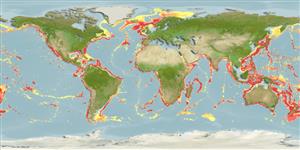Common names from other countries
Environment: milieu / climate zone / depth range / distribution range
Sinh thái học
Biển Tầng đáy biển sâu; Mức độ sâu 120 - 2000 m (Ref. 50610). Deep-water
Throughout the world ocean in tropical and temperate latitudes (Ref. 9842). Eastern Atlantic: one specimen from off Cape Bojador south of the Canary Islands; unrecorded specimens taken between Guinea and Angola. Western Atlantic: Canada (Ref. 5951) to the Gulf of Mexico (Ref. 29076). Western Indian Ocean: off Madagascar. Eastern Pacific: one specimen captured off northern central California, USA (Ref. 2850). Western Pacific: Japan to New Caledonia, Australia (Ref. 7300) and New Zealand (Ref. 5755).
Bộ gần gũi / Khối lượng (Trọng lượng) / Age
Maturity: Lm ? range ? - ? cm
Max length : 39.0 cm TL con đực/không giới tính; (Ref. 5951)
Các tia vây lưng cứng (tổng cộng) : 0; Các vây lưng mềm (tổng cộng) : 19 - 22; Tia cứng vây hậu môn: 0; Tia mềm vây hậu môn: 15 - 18. Mouth large, maxillary extending far beyond eye (Ref. 559) Lower jaw projecting beyond the upper (Ref. 559). Teeth on both jaws broad villiform bands (Ref. 559). Body and each fin with minute spinules, the surface velvety to the touch. Lateral line opening as distinct pores (Ref. 559).
Juveniles mesopelagic, adults benthopelagic. Presumably feed on crustaceans.
Life cycle and mating behavior
Maturities | Sự tái sinh sản | Spawnings | Egg(s) | Fecundities | Ấu trùng
Paxton, J.R. and D.J. Blake, 1990. Barbourisiidae. p. 606. In J.C. Quero, J.C. Hureau, C. Karrer, A. Post and L. Saldanha (eds.) Check-list of the fishes of the eastern tropical Atlantic (CLOFETA). JNICT, Lisbon, SEI, Paris; and UNESCO, Paris. Vol. 2. (Ref. 4500)
IUCN Red List Status (Ref. 130435)
CITES (Ref. 128078)
Not Evaluated
Threat to humans
Harmless
Human uses
Các nghề cá: không ích lợi (thú vị)
Các công cụ
Special reports
Download XML
Các nguồn internet
Estimates based on models
Preferred temperature (Ref.
115969): 3 - 12.3, mean 7.1 (based on 2015 cells).
Phylogenetic diversity index (Ref.
82804): PD
50 = 1.5000 [Uniqueness, from 0.5 = low to 2.0 = high].
Bayesian length-weight: a=0.01122 (0.00514 - 0.02450), b=3.04 (2.87 - 3.21), in cm Total Length, based on all LWR estimates for this body shape (Ref.
93245).
Mức dinh dưỡng (Ref.
69278): 3.3 ±0.41 se; based on food items.
Fishing Vulnerability (Ref.
59153): Low to moderate vulnerability (29 of 100).
